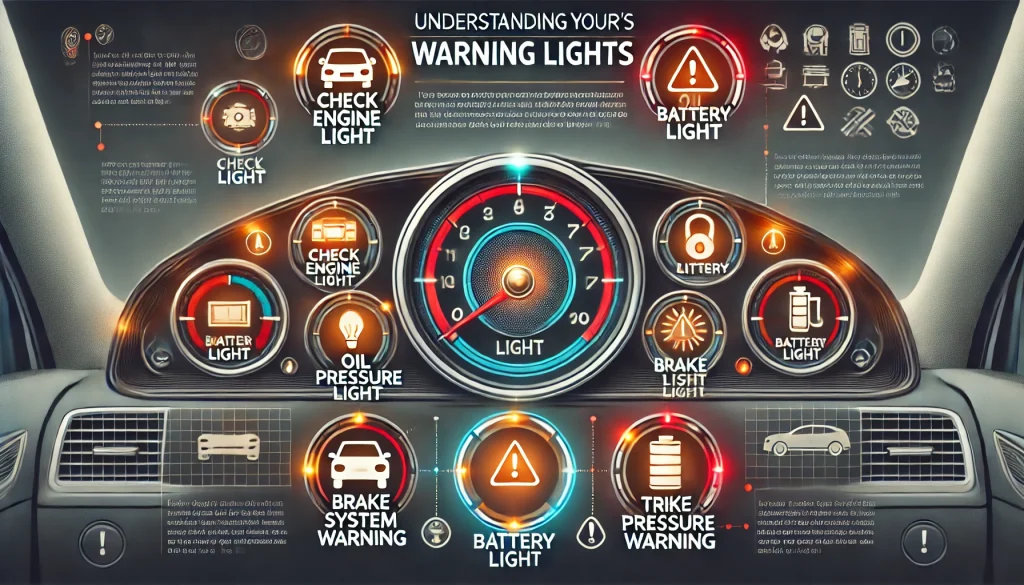Understanding dashboard warning lights is paramount to automotive safety. These lights act
as vital indicators, alerting us to potential issues with our vehicle’s systems. Being well-versed in
the meanings of these symbols ensures that we can respond promptly to maintain our car’s
health and safety on the road. This comprehensive guide delves into the meanings of car
warning lights, equipping you with the knowledge needed to interpret these crucial signals.
Let’s explore the world of car dashboard symbols and their implications.
Engine Warning Light (Check Engine Light)
The engine warning light, often labeled the check engine light, signals various potential issues
within your vehicle’s engine or emissions system.
What It Means: This light can be triggered by something as minor as a loose gas cap or as
severe as a malfunctioning catalytic converter.
What to Do: If the light is steady and your car seems to be driving usually, you can continue
driving but should have it checked soon. If the light is flashing, it’s best to pull over and seek
professional assistance immediately to prevent potential engine damage.
Oil Pressure Warning Light
The oil pressure warning light indicates problems with your car’s oil pressure system.
What It Means: This light could mean you’re running low on oil or that the oil pump isn’t
circulating enough fluid.
What to Do: Pull over safely, check your oil levels, and look for any leaks. If the oil level is
adequate but the engine is noisy, it might be an oil pump issue. If everything seems normal, the
oil pressure sensor could be faulty.
Battery System Warning Light
This warning light signals an issue with the vehicle’s charging system.
What It Means: Possible causes include a loose or damaged battery cable, a faulty alternator,
or other electrical faults.
What to Do: If this light comes on, it’s crucial to have your vehicle checked. Ignoring it could
cause your car to not start.
Brake System Warning Light
This light indicates an issue with the braking system, including the brake fluid level or brake
pads.
What It Means: Low brake fluid or worn brake pads are common triggers.
What to Do: Check the brake fluid level and add more if necessary. If the light remains on, seek
professional assistance to inspect your brakes.
Temperature Warning Light
The temperature warning light shows that your engine is overheating.
What It Means: This usually relates to the coolant level or the cooling system.
What to Do: Turn off the A/C, turn on the heater, and pull over safely. Before tracking the
coolant level, let the engine cool. Do not open the hood if the engine is still hot.
Anti-lock Braking System (ABS) Warning Light
The ABS warning light indicates a malfunction in the anti-lock braking system.
What It Means: The ABS helps prevent wheel lock-up during hard braking, especially on
slippery roads.
What to Do: Have a mechanic diagnose the issue as soon as possible to ensure your ABS is
functioning correctly.
Traction Control Light
This light signifies that the traction control system is active.
What It Means: It indicates that the system is working to prevent wheel spin and maintain
traction.
What to Do: Continue driving with caution, especially on slippery surfaces.
Traction Control Malfunction Light
This light indicates an issue with the traction control system.
What It Means: There could be a sensor failure or another issue within the system.
What to Do: While this might not affect everyday driving, it’s best to get it checked to ensure the
system functions correctly in adverse conditions.
Tire Pressure Warning Light
The tire pressure warning light, also known as the Tire Pressure Monitoring System (TPMS)
symbol, indicates an issue with the tire pressure.
What It Means: It signals that one or more tires are either underinflated or overinflated.
What to Do: Stop and check your tire pressure, adjusting as necessary. If the light remains on,
there could be a problem with the TPMS sensors.
Airbag Indicator Light
The airbag indicator light alerts you to a problem with the airbag system.
What It Means: A malfunction in the system could cause the airbag to not deploy correctly in an
accident.
What to Do: Have your car inspected immediately to ensure your safety.
Seat Belt Reminder Light
This light reminds you or your passengers to fasten seat belts.
What It Means: It typically comes with a beeping sound to ensure compliance.
What to Do: Buckle up to deactivate the light and ensure safety.
Security Indicator Light
This light is part of the anti-theft system.
What It Means: A blinking light indicates the system is armed. A steady light may indicate a
malfunction or a triggered immobilizer.
What to Do: If the car is immobilized, reset the system according to your manual or seek
professional help.
Low Fuel Indicator Light
This light means that your vehicle is running low on fuel.
What to Do: Refuel at the earliest convenience to avoid being stranded.
Automatic Shift Lock or Engine Start Indicator Light
This light appears when you attempt to shift gears or start the engine without engaging the
brake.
What to Do: Press the brake pedal to proceed.
| TIPS | |
| Regular Maintenance | Follow your maintenance schedule to keep all systems in check. |
| Verify Fluid Levels | Check the levels of coolant, brake fluid, and oil on a regular basis. |
| Monitor Tire Pressure | Keep an eye on tire pressure to ensure safe |
| Listen for unusual sounds | Strange noises can be an early indicator of potential issues. |
| Use Quality Fuel and Oil | High-quality fuel and oil can improve engine performance and longevity. |
Final Thoughts
Understanding your car’s dashboard warning lights is crucial for maintaining vehicle
performance and safety. These lights are your car’s way of communicating with you about
potential issues that need attention. By promptly addressing these warnings, you can prevent
minor problems from becoming major repairs.
FAQs
Q1: What should I do if my check engine light comes on?
If your check engine light is steady and your car seems to be driving normally, you can continue
driving but should have it checked soon. Suppose the light is flashing.It’s best to pull over and
seek professional assistance immediately to prevent potential engine damage.
Q2: How often should I check my car’s oil level?
It’s recommended that you check your oil level at least once a month. Regular checks ensure
that your engine is properly lubricated and can help prevent significant issues.
Q3: Can I drive with the ABS warning light on?
While you can technically drive with the ABS warning light, it’s not advisable. The ABS is a
critical safety feature, and driving without it functioning correctly can be dangerous, especially in
slippery conditions.Get a mechanic to look it over as soon as you can.
Q4: What does the tire pressure warning light mean?
The tire pressure warning light indicates that one or more of your tires are underinflated or
overinflated.As necessary, check and modify your tire pressure. If the light remains on, there
could be an issue with the TPMS sensors.
Q5: Why does the car’s battery warning light come on?
The battery warning light signifies a problem with the vehicle’s charging system. This could be
due to a loose or damaged battery cable, a faulty alternator, or another electrical fault. Have it
checked promptly to avoid being stranded.


